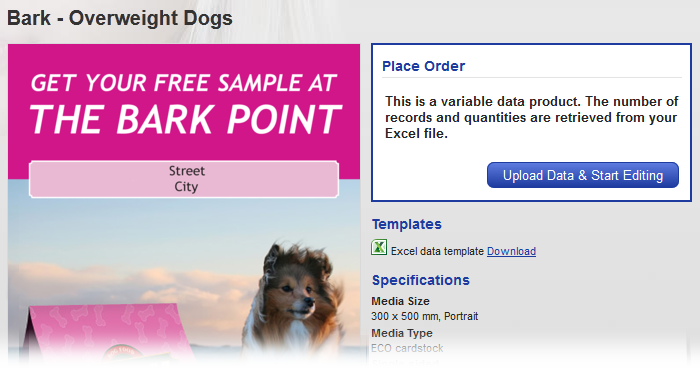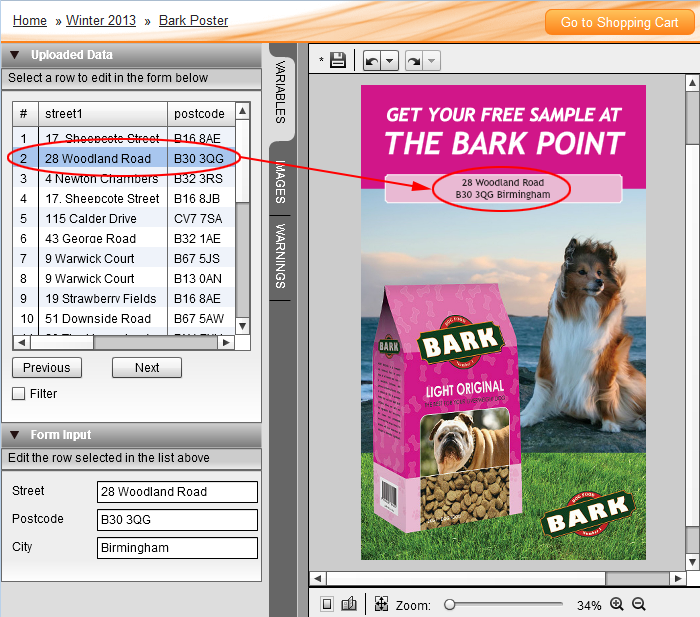:Apogee StoreFront in-depth
Variable Data Processing (VDP)
Within the Apogee StoreFront web-to-print solution variable data processing or VDP allows print service providers to create customizable products for which the data are supplied by the print buyer as an Excel file. This way the shopper can order a range of products in one go, instead of repeatedly filling in a form to personalize a product. Some typical uses are:
- Upload a spreadsheet with 45 names and contact details to create 45 sets of business cards
- Upload 30 store addresses to print fashion posters that point customers to the nearest retail store
- Personalize 80 letters with a name and address for a direct marketing campaign
Ordering a VDP product
- When a shopper navigates to a VDP product page, the order button clearly indicates data need to be uploaded. The example below shows a poster in which store addresses from the uploaded Excel file are inserted.

- From that product page the user can optionally download a template Excel file. This sample file indicates which data are needed to order the product. The spreadsheet contains two worksheets:
- The first worksheet contains the actual data to be used for the variable data processing, with all the required variables in the header row. The user can enter his data in the subsequent rows, either by entering them manually or using COPY-PASTE from another file.
- The second worksheet provides help and lists the variables, their type (text, number, list..), the required syntax and whether they are mandatory or not.
- To order the product the user has to click the âUpload Data & Start Editingâ button. This opens a File Upload window which provides some additional information about the required data.

- After a file is uploaded the data are preflighted. The user is warned if mandatory data are missing or the data do not match the requirements. He or she can then download an Excel spreadsheet in which all the incorrect cells & columns are color coded. After correcting any errors a new file can be submitted.
- Once the supplied file passes the preflight check, the Online Editor opens and the user can see the first record. By navigating through all the records, each one can be checked visually to see if the resulting layout is correct.
- The user can browse through the records and visualize each one of them.
- There is an option to filter the shortest and longest value of each field, making it easier to check how well the supplied data fit in the space that is foreseen.
- It is also possible to do last minute corrections using the form underneath the navigation pane.

- After submitting the job to the shopping cart, it becomes an order item and the final quantities (and possibly pricing) will be shown.

- Like any other order, a VDP order can go through an approval cycle.
- A VDP order can afterwards be reordered. The user can however only reorder the entire order item, not specific records. If the latter is needed, it is recommended to reuse the Excel datasheet, delete all the records that are not needed and use this file to create a new order. Users can download the Excel datasheet from their order history, specifically to facilitate reordering.
Processing a VDP order
- In the Product and Order lists, variable data products have their own icon:

- In the Apogee Prepress production workflow VDP orders show up as either single jobs or as multiple jobs, depending on the product definition.
- If one single copy gets printed of every record:
- For unbound products either one single prepress job containing all pages is created or multiple jobs are created. The latter happens if the order item exceeds 100 records.
- For bound self cover products a separate prepress job with 1 part (Body) is created for every record.
- For bound separate cover job a separate prepress job with 2 parts (Cover and optionally a Body) is created for every record.
- If multiple copies get printed of each record:
- For unbound products either multiple JDF Parts are combined in one prepress job or multiple jobs are created (the latter happens if the order item exceeds 100 records).
- For bound self cover products a separate prepress job with 1 part (Body) is created for every record.
- For bound products with a separate cover a separate prepress job with 2 parts (Cover and optionally a Body) is created for every record.
- If a VDP order is split across multiple prepress jobs, its descriptive name will indicate this, e.g. ‘VDP Direct Mailing [1-100 of 364]’ or ‘Summer Campaign [1 of 4]’.
Specifications
- Variable data need to be supplied in an Excel .xls datafile. Additional data formats such as .xlsx or .csv are not (yet) supported. The current release also support only text-based variable data. Image support is not (yet) available.
- There are 3 ways to specify how many copies of each record need to be printed. The copy count can be:
- specified in the Excel file – A separate column labelled ASF_QUANTITY in the Excel file determines how many prints of each record are needed.
- specified in the product page – The buyer selects a quantity and for each record that quantity will be printed.
- one copy per record – This is typically used for direct mailing where each personalized letter or card only gets printed once.
- Variable data products can be based on the following product template base types:
- Unbound - Flat
- Unbound - Folded
- Bound - Self Cover
- Bound - Separate Cover. For bound products, a fixed number of pages should be defined. The system will not add additional pages to a document if the variable content does not fit on the space that is foreseen.
- The total number of records that can be processed within one order item depend on the way the product will get processed:
- If the quantities are specified on the product page or embedded in the Excel file, a VDP order can contain up to 200 records.
- For single copy products, the order can contain up to 100 records for unbound products and 50 records for bound products.
Availability
Variable data processing is a separate option which is not part of the regular StoreFront license. Contact your Agfa sales representative or dealer for more information on pricing and availability.


 RSS
RSS
